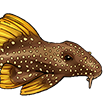Progressive deteriation of the broad leafed plants in my discus tank, skeletising of the leaves, yellow round patches.
New leaves are fine if a bit crinkly, but eventually they all go like this.


underside of same leaf (Echidorus sp ?)

and an anubus nana ?


Other plants in the tank, cardimine, chain swords, dwarf sag. Vallisineria grow fine and need regular trimming, but the 3 species of sword plant and the anubus all suffer from the same problem.


ph is 6.8
temp is 28c
NO3 is 3ppm
FE is 0.2 (JBL test kit)
PO4 is .25
2x DIY C02 producing about 1 bubble / 4 secs total (not enough but best I can get at moment)
Daily dose of eheim plant fertiliser from liquidoser.
Daily 5ml dose of Flourish Excel to supplement the C02.
Weekly 5ml dose of Flourish.
Substrate is fine gravel with JBL Aquabasis on bottom, plus undergravel heating cable and Fertiliser balls spread randomly about.
4x Discus 18x Cardinal Tetra 2x Gold Nugget Plecs 2x Twig Cats 4x Sterbai Cory 6x Otto Cats
When the tank was first set up all plants did fantastically, including broad leafed ones, after about 18 monthes this problem started to appear and I needed to move the tank so I stripped it down, reset it up thinking that all would come right, but problem still persists in braodleafs only, everything else is fine.
Any opinions, help, ideas greatly appreciated.




